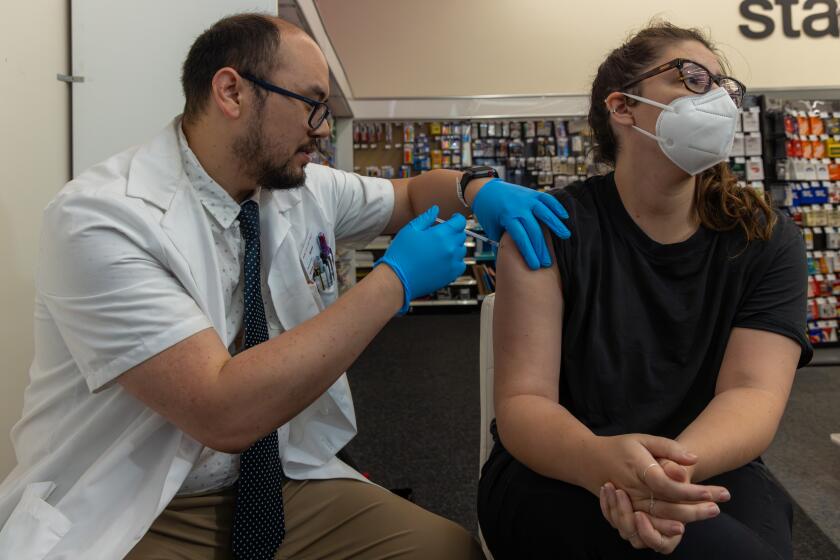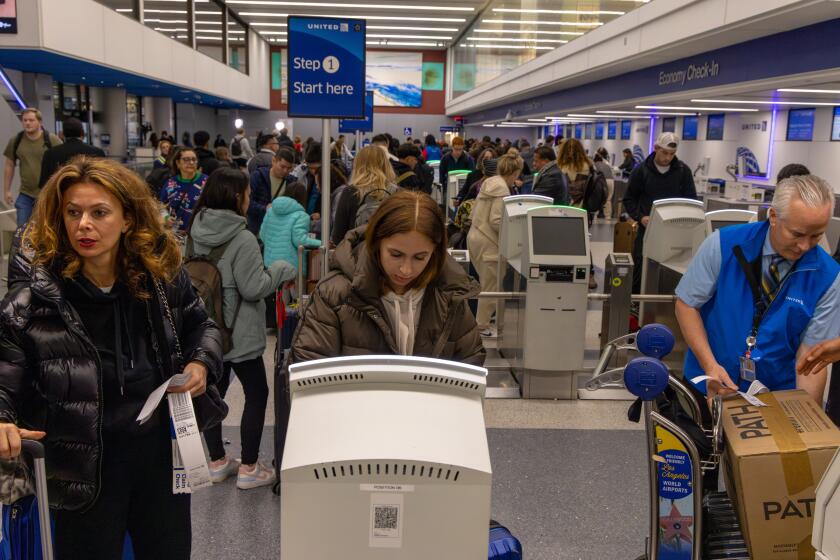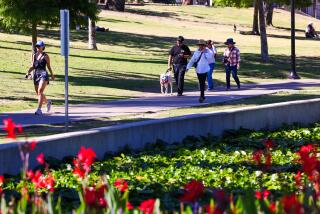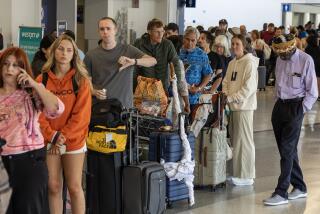With COVID on the rise, your at-home test may be taking longer to show a positive result
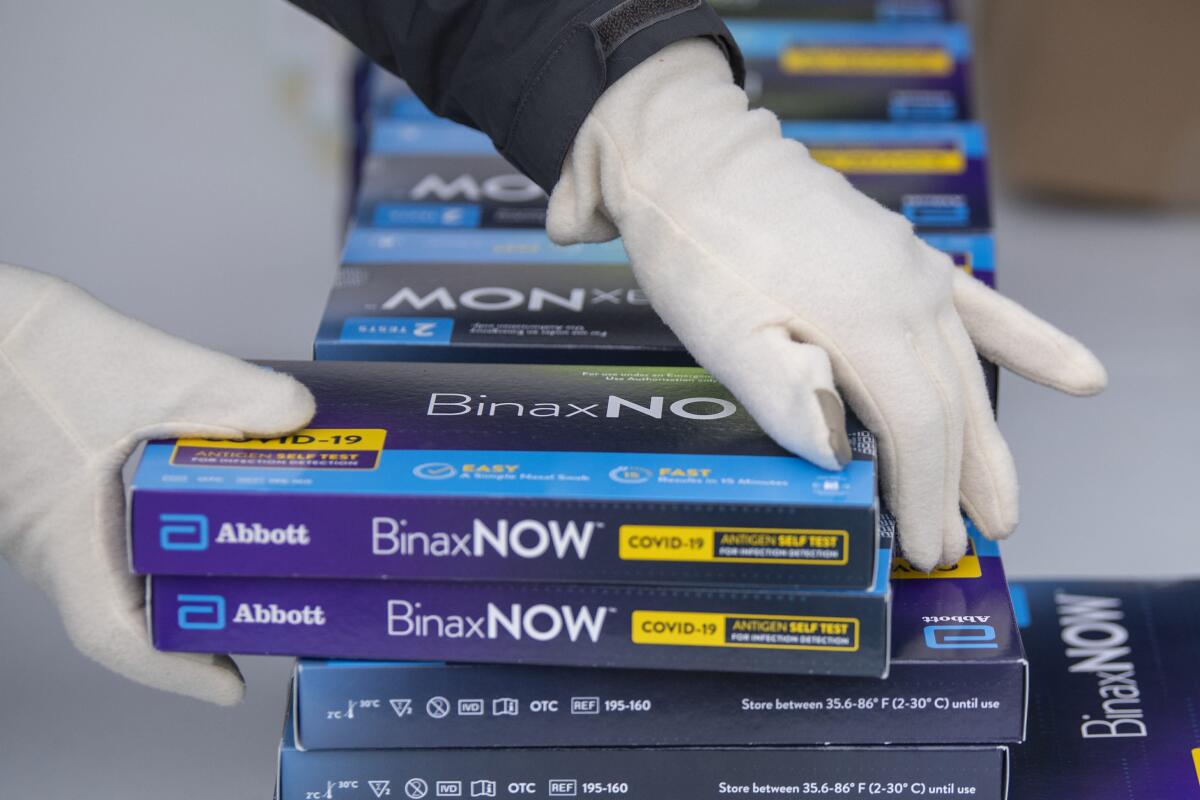
With COVID-19 rising this winter, it’s getting more complicated to discern whether you are infected.
Dr. Elizabeth Hudson, regional chief of infectious diseases at Kaiser Permanente Southern California, said she has noticed it’s sometimes taking longer after the onset of symptoms for rapid tests to return a positive result.
For the record:
4:10 p.m. Jan. 12, 2024An earlier version of this article listed an incorrect URL for ordering free at-home tests through the federal government. The correct link is COVID.gov.
It used to be that someone might test positive for the coronavirus one or two days after the onset of symptoms using a rapid test, Hudson said. Now, positive results might not show up until the fourth day after symptoms start.
What is causing the lag?
The delay in accurate test results is probably a result of people having accumulated immunity from COVID-19 over the years, whether from vaccinations or previous infections, Hudson said.
“It’s actually pushing back the time that people’s COVID tests are coming up positive. So some people are testing at Day 1 and Day 2 and saying, ‘Oh, it’s negative, I don’t have COVID,’” Hudson said. “If they probably tested themselves a couple of days later, there’s a pretty good chance that it actually would turn out to be COVID.”
People who initially test negative for COVID-19 despite having symptoms and don’t retest later “could be getting a false sense of security” that they don’t have the illness when they actually do and are contagious, Hudson said.
California’s hospitals are getting busier with more COVID-19 and flu patients. Los Angeles County recently entering the ‘medium’ COVID-19 category for the first time this winter.
What are the recommendations for testing?
Test immediately if you have symptoms of COVID-19, the U.S. Centers for Disease Control and Prevention says. If you take an at-home rapid test, also referred to as an antigen test, a positive result is usually reliable.
But a negative test does not always mean you don’t have COVID-19.
It can take a few days for virus levels to reproduce in quantities high enough to be detected by a rapid test.
If you test negative and have COVID symptoms, the CDC suggests taking a second test 48 hours later. In the meantime, because you are ill, officials say you should stay home and away from other people or mask up if you need to be around others.
Another option is heading to your medical provider to take a PCR test, which generally means going into a medical facility and having your test processed by a lab. “That test is much more sensitive. And that [positive test result] would come up sooner,” Hudson said.
But most people rely on taking at-home tests. And if that second at-home test is negative, experts recommend taking another one four days after the onset of symptoms.
“They should really, probably on Day 4, retest themselves if they’re doing the home antigen test,” Hudson said.
Generally, at-home rapid COVID-19 tests detect a coronavirus infection at least 80% of the time, according to the Food and Drug Administration.
By contrast, a lab-based PCR test generally detects the virus 95% of the time. But PCR tests can take a day or longer to process, while rapid test results are available within 15 minutes.
New data show pronounced recent jumps in the rate at which coronavirus and flu tests are coming back positive, as well as the number of hospital-admitted patients testing positive for the viruses.
What if you’re asymptomatic but have been exposed?
You should get tested five days after you were last exposed to someone who was infected with COVID-19, the CDC says.
If the test is negative, take another at-home test two days later, or a PCR test as soon as you can. If the second at-home test result is negative, take a third at-home test two days after the second.
Are there other times when it’s helpful to test?
Testing before an event or visiting someone who is at higher risk can be helpful, the CDC says. Sometimes, a rapid test can detect an infection before symptoms have begun. It’s also possible a rapid test can detect an infection for someone who is asymptomatic.
“Test as close to the time of the event as possible, at least within one to two days,” the agency says. “If you use an antigen test, follow recommendations for repeat testing to be confident in a negative result.”
Coronavirus transmission is once again spiking in California entering the winter holiday season — and the new JN.1 subvariant may be partly to blame.
Where we stand with COVID
Coronavirus cases are up. But the number of people becoming seriously ill remains lower than last year, when hospitals were deluged by a “tripledemic” of COVID, flu and respiratory syncytial virus, or RSV.
Nationally, there were 34,798 new coronavirus-positive hospital admissions for the week that ended Dec. 30, a 20% jump over the prior week and the highest one-week total in nearly a year. Last winter peaked at 44,542 new hospital admissions for the week ending Dec. 31, 2022.
California recorded 3,516 new coronavirus-positive hospital admissions for the week that ended Dec. 30, a 7% increase from the previous week, according to data from the CDC. The state’s peak last winter was 5,260 new hospital admissions for the final week of 2022.
Since Oct. 1, the CDC has reported an average of about 1,400 COVID-19 deaths a week nationally. Over the same time period last year, there were about 2,400 weekly COVID-19 deaths.
Seven California counties on Friday joined the CDC’s medium level of coronavirus-positive hospitalizations from the low level: Orange County; Alameda and Contra Costa counties in the Bay Area; and in the Central Valley and Sierra, Stanislaus, Merced, Tuolumne and Mariposa counties. Los Angeles County and the four-county Sacramento area were already in the medium level.
What about JN.1?
A more contagious subvariant may be aiding the spread of COVID-19.
Nationally, the subvariant JN.1 was estimated to account for 62% of coronavirus specimens for the two-week period that ended Saturday; it accounted for 39% of specimens for the prior comparable period.
How can you get a COVID-19 test?
The U.S. government is allowing residents to order free at-home COVID tests through COVID.gov. People are able to order four free at-home tests per household. And if they didn’t already place an order between Sept. 25 and Nov. 19, they’re eligible for two separate orders of four tests.
In general, doctors and health plans remain responsible for providing free COVID tests to patients assigned to them, according to the Los Angeles County Department of Public Health.
At-home COVID tests are on sale at pharmacies and online retailers. In California, state law still requires most health plans — those regulated by the state — to reimburse for the cost of eight at-home test kits per month. But residents should check with their health plan on details of reimbursement and whether they need to purchase them through an in-network provider to get fully reimbursed.
There may be some Medicare patients who don’t qualify for free at-home test kits. However, COVID-19 testing is free if ordered by a doctor. And some with Medicare Advantage plans may still be eligible for free at-home COVID tests.
Free tests are available in a number of settings in Los Angeles County, including at libraries, senior centers and food banks. More information can be found at ph.lacounty.gov/COVIDtests or by calling (833) 540-0473.
The CDC has set up a website, testinglocator.cdc.gov, that displays sites that offer free COVID-19 tests for uninsured people who are ill or have been exposed to the virus.
A program funded by the National Institutes of Health, featured at test2treat.org, gives adults who test positive for COVID-19 or flu free access to telehealth care and treatment. That program is expected to run through early summer. Adults who aren’t positive can still enroll to get free tests shipped to them if they are uninsured or underinsured; on Medicare or Medi-Cal; or in the healthcare system of the Department of Veterans Affairs or the Indian Health Service.
More to Read
Sign up for Essential California
The most important California stories and recommendations in your inbox every morning.
You may occasionally receive promotional content from the Los Angeles Times.

